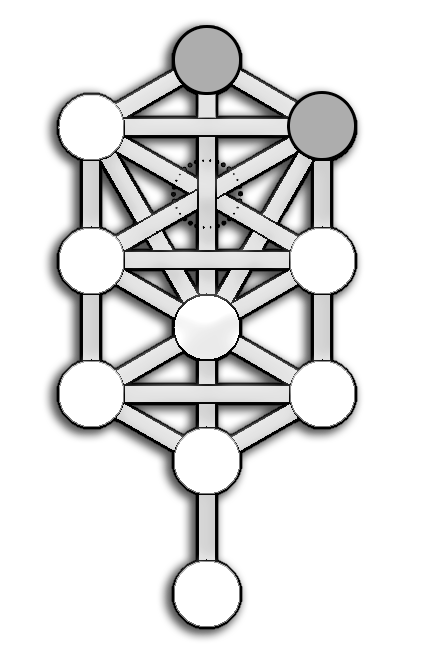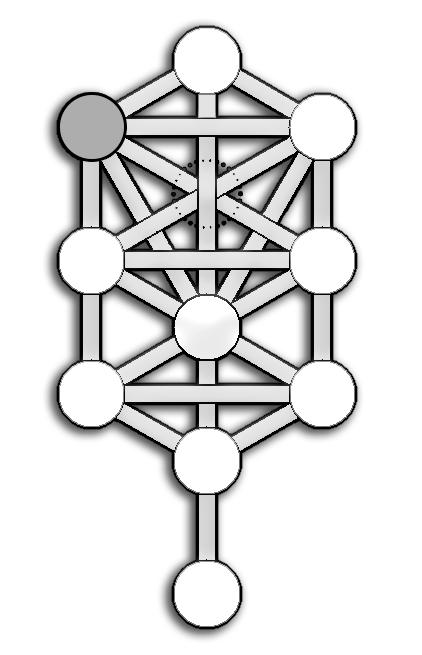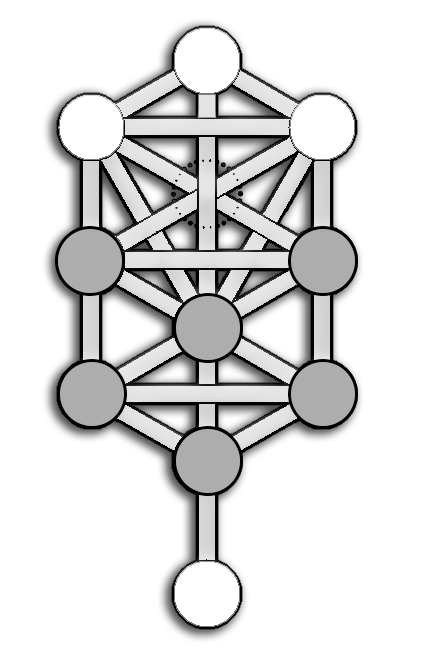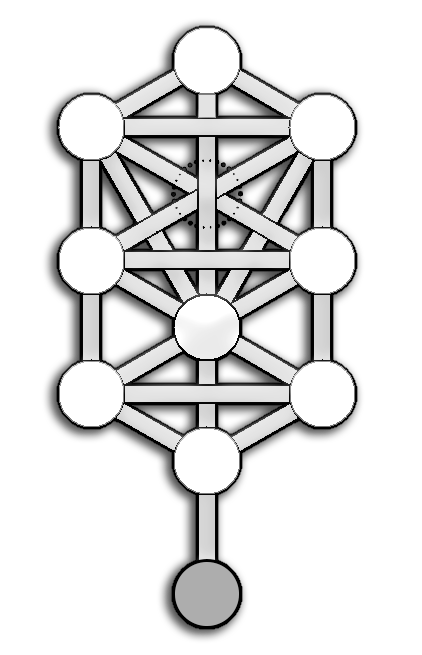Olamot | עולמות
At the heart of Qabalistic thought, three fundamental structures form the backbone of its intricate language: the Ten Sephiroth, the Twenty-Two Letters, and the Four (or Five) Worlds. These components serve as key building blocks for the manifestation of being in Qabalistic doctrine.
In the realm of Qabalah, the materialization of the Absolute, transcending the veils of Non-existence, Infinity, and Endless Light, unravels through four Worlds or layers. Each of these layers is a holistic universe within itself, yet they remain interconnected, maintaining both hierarchical and holographic relationships.
From the apex to the base, the four worlds are:

Atziluth:
The world of Atziluth, the world of emanation, is where divinity makes its home. It embodies the manner in which the divine entity decides to arrange or morph itself to actualize its existence.
Above these four worlds, sits the Ein Sof, the epitome of infinity, the absolute, and the world without an end - it's the realm obscured by the veils of negative existence. It is crucial to understand that there is no discontinuity between the divine world, the world of emanation, and the plane of Ein Sof. We distinguish them as two separate levels solely because we rely on our minds, which can only function through the constructs of concepts, divisions, and boundaries.
The divine world is also known as the realm of G'd's Names. A Qabalistic aphorism encapsulates this concept, saying "He and His Name are one". This signifies that there exists no partition between the plane of the manifested Deity, represented by the Sacred Names of G'd, and the plane of the hidden essence.
Each of these worlds hosts a complete Tree of Life, boasting its Sefirot, pathways, entities (within the plurality domains), regions, and subplanes. The Sefirot of the Atziluth world are occasionally termed as Divine Faces, also known as Partzufim. They represent the various forms in which the Sefirot shape themselves and interact with each other. Sometimes, as referenced in the Sefer Yetzirah, they are called Depths or infinite dimensions:
"Ten sefirot of nothingness, the depth of the beginning (or the infinity of the beginning), the infinity of the end, the infinity of good (or the positive constructive force), the infinity of evil (or the negative destructive force), the infinity of the high, the infinity of the low, etc."Interestingly, the term Atziluth in Hebrew does not directly translate to 'emanation'. It stems from two etymologies, composed of identical letters but with different pronunciations:
• "Etzel": connoting proximity, closeness, or association.
• "Atzal": signifying removal, withdrawal, or abstraction.
This dual etymology gives rise to a paradoxical conception: On one hand, the world of Atziluth is the most abstract, the most removed, the furthest, while on the other, it is infinitely near. It is perceived as the polar opposite of our existence, yet it resides infinitely close to us. It permeates everything, everywhere.
Atziluth represents the realm of absolute reality, the nucleus of true reality. Collectively, the plane of Ein Sof, along with the world of Atziluth, are typically referred to as "The Creator". This highlights the profound interconnectedness within Qabalah between the individual parts and the greater whole, and the innate duality present in the most fundamental elements of our universe.

Beriyah:
Beriyah is synonymous with the world of creation, a realm where the concept of "something" takes shape from the essence of "nothing." This paradoxical "nothing" corresponds to the world of Atziluth, representing a form of non-existence that paradoxically embraces fullness and true life—an unconditioned emptiness. To us, it is nothingness merely from our point of reference. A universal pattern emerges, whereby each world appears as an abstraction, a void to the one beneath it.
From a physical perspective, what does the mind embody? Where does it dwell? The mind appears as an elusive, almost non-existent entity. Yet, we experience its potency directly and are thoroughly convinced of its existence. The same holds true when we consider the other planes of existence.
Hence, the world of Atziluth, superior to all cognitive domains, seems like an abstraction to us because our understanding is dictated by mental categories. That is unless we nurture the inherent capability for direct spiritual vision, an intimate understanding of the divine.
Therefore, the realm that unfolds from Atziluth can be conceptualized as Being that germinates from the seedbed of Nothingness. Indeed, another term for the world of creation is the world of existence, embodying pure and simple being beyond all semblance of form. Form is an attribute of the subsequent world: Yetzirah.
Beriyah is a universe of unadulterated qualities. We thus speak of concepts like Good, Truth, Beauty, and so forth. These qualities are elements that beings can partake in or emit, enabling their perception. Yet, the quality in its fundamental essence is part of the Pure Being of Beriyah.
Beriyah is the domain of authentic Being, where every element is saturated with Light, Fullness, Excellence, and Bliss. At times, it is referred to as the world of the Throne or G'd's Throne. This nomenclature is employed because these qualities form the foundation of the Divine, providing the pedestal upon which the Divine's manifestation rests.
Beriyah, in particular, is portrayed as the Seat or the Throne of Shekhinah; that facet of the Divine Presence, the Partzuf symbolizing the Malkuth of Atziluth radiating through the world of Beriyah. This makes Beriyah the Throne of Divine Glory.
The Sefirot of Beriyah, when referred to as places, are designated as "Palaces" (the Hechalot). The denizens of the Beriyah world comprise Archangels (creative intelligences or powers) and the spiritual souls (the Neshamot).
The human soul comprises a fivefold principle, each corresponding to one of the worlds plus the plane of Ein Sof. This aspect of the spirit soul or spirit is associated with the world of Beriyah. This underscores the deeply intertwined relationship of the human soul with the layered spiritual universe, an intrinsic connection to each plane of existence, and the continuum of spiritual development that stretches from the Ein Sof to the finite human experience.

Yetzirah:
Yetzirah signifies the world of formation. If we perceive Beriyah as the Being birthed from Nothingness, then Yetzirah represents the plane of Being created from Being; a realm where something materializes from something pre-existing, where an already existing entity is granted form. It is a domain teeming with forms, words, images, and mental content.
When we refer to the pure mind, transcending form, we are discussing the essence of Beriyah. On the other hand, when we talk about the mind and its contents, we delve into the realm of Yetzirah. By pure or abstract mind, we signify the absence of thoughts or any other concrete or distinguishable elements.
Generally, in our existing condition, the world of Yetzirah is perceived internally. It is the realm of our subjectivity, the rich tapestry of our psyche. Beriyah and Atziluth are worlds that linger on the periphery of our consciousness, shrouded in mystery, although we acknowledge them as unseen variables in our existential equations. We are aware of their existence, but we lack a sustained, direct experience of them. However, we occasionally get a glimpse of these realms; when we behold, for instance, a manifestation of beauty so profound that it lifts us above our individual ego and ushers us into the spirit's expanse. In those fleeting moments, we touch the essence of Beriyah.
Specifically, Yetzirah is the world of our internal psyche, of our subjectivity. Nonetheless, it can also be experienced as an objective reality, as an external world, particularly in states of sleep or post-death, when we are freed from our physical vessel. This perception is also experienced in instances of astral projection.
In the esoteric realm, Yetzirah is often synonymous with what is known as the astral world. The formative powers of its various spheres or Sefirot are vested in the Angels (the Angelic Choirs). This plane also corresponds to a segment of the human soul, identified as the Ruach.
When the sefirot of Yetzirah are referenced as objective locales in the macrocosm, they are named the 'seven heavens'. On a microcosmic scale, they resonate with different psychic functions such as the intellect, emotions, and so forth.
In a more detailed understanding, Yetzirah is not just a plane of existence, but it also represents the conscious thought process and mental constructs that human beings experience daily. It stands for our emotions, our thoughts, our dreams, and every non-physical yet tangible aspect of our being. It's where abstract ideas are given a form and subsequently evolve into something more concrete, bridging the gap between the immaterial and material world, the abstract and the concrete. This concept further emphasizes the interconnectedness of all levels of reality, each feeding into and shaping the other in an endless dance of creation and transformation.

Assiah:
Assiah represents the world of action, the sphere of actualization, concretion, matter, energy, space, and time, as we comprehend them within our earthly perceptions. The concept of time in Assiah, unlike in other worlds, is a linear progression rather than an interconnected web of archetypes. Archetypal time, within the Qabalistic cosmology, establishes a relationship with Chokmah, while flowing time (as we understand it) finds its connection with Binah in Assiah.
This is the realm where the physical bodies and matter are found, the dominion of tangible substance. It also houses the subtle levels of energy where, for instance, elemental kingdoms are situated, along with the entities commonly referred to as spirits and planetary intelligences.
These planetary intelligences and spirits correspond to what are typically referred to as elemental beings within the macrocosm. Broadly speaking, they function as the links or connecting hubs through which planets exert influence in the world of Assiah. They serve as active forces that shape and mold the material world according to celestial influences.
To elaborate further, Assiah is a dynamic realm that represents the culmination of the processes of creation, formation, and manifestation. It symbolizes the densest level of existence where spiritual ideas take physical form, and metaphysical concepts materialize into perceptible reality. It is the realm that holds a unique status in the Qabalistic tree of life, as it serves as the concrete expression of all the abstract principles and concepts that originated and evolved in the preceding worlds of Atziluth, Beriyah, and Yetzirah.
In Assiah, we encounter the forces and entities that translate the abstract principles from the higher worlds into material reality. For instance, the elemental kingdoms represent various forms of energy that constitute the fabric of the physical universe. They embody fundamental principles of transformation and change that underlie the physical processes of nature.
Similarly, the spirits and planetary intelligences represent the interaction between the macrocosm (the universe) and the microcosm (the individual). They function as intermediaries, translating and implementing the divine will as manifested through the celestial bodies in the tangible world. They are instrumental in maintaining the order of the universe and orchestrating the cosmic dance of creation and transformation.
The complex interplay of these diverse forces within Assiah encapsulates the richness and dynamism of the material universe. It reflects the intricate network of relationships and interactions that bind together the various levels of existence in a unified, harmonious whole. This profound understanding of Assiah underscores the fundamental Qabalistic principle that the material world is not separate or distinct from the spiritual realms but rather represents their fullest and most concrete expression.
